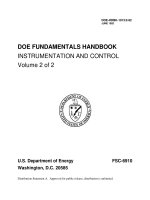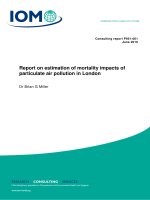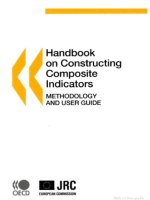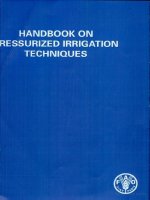Pictorial Handbook on Spiders of Sunderbans West Bengal
Bạn đang xem bản rút gọn của tài liệu. Xem và tải ngay bản đầy đủ của tài liệu tại đây (11.01 MB, 147 trang )
IfJil(C(j({f)lfll@JU JJ!!@JlJfJ@}!JJJ@({])!k ([})l!iJ
Siders of S nderba s
West Benga
s.c. MAJUMDER
ZO'O OGICAL SURVEY OF I
IA
Pictorial Handbook on
Spiders of Sunderbans
West Bengal
s.c.
MAJUMDER
Zoological Survey of India, 23414, A.i. C. Bose Road, 13th Floor, Nizam Palace,
Kolkata 700 020
Edited by the Director, Zoological Survey of India, Kolkata
Zoological Survey of India
Kolkata
CITATION
Majumder, S.C. 2007. Pictorial Handbook on Spiders of Sunderbans, West Bengal: 1-137.
(Published by the Director, Zool. Surv. India, Kolkata)
Published : February, 2007
ISBN 81-8171-137-8
Cover,. Photo : Leucauge decorata (Blackwall); Courtesy : Shri Sankar TaIukdar
© Govt. of India, 2007
ALL RIGHTS RESERVED
•
•
•
No part of this publication may be reproduced stored in a retrieval system or transmitted in
any form or by any means, electronic, mechanical, photocopying, recording or otherwise
without the prior permission of the publisher.
This book is sold subject to the condition that it shall not, by way of trade, be lent, resold hired
out or otherwise disposed of without the publisher's consent, in an form of binding or cover
other than that in which, it is published.
The correct price of this publication is the price printed on this page. Any revised price
indicated by a rubber stamp or by a sticker or by any other means is incorrect and should be
unacceptable.
PRICE
Indian Rs. 1,000.00
Foreign: $ 75; £ 60
Published at the Publication Division by the Director Zoological Survey of India, 234/4,
AJ .C. Bose Road, 2nd MSO Building, 13th floor, Nizam Palace, Kolkata 700020 and
printed at Power Printers, New Delhi - 110 002.
CONTENTS
INTRODUCTION ....................................................................................................................... 1
SYSTEMATIC LIST ................................................................................................................... 1
Key to the fatnilies ................................................................................................................. 7
Key to the genera ................................................................................................................... 8
Key to the species ................................................................................................................ 10
SYSTEMATIC ACCOUNT ....................................................................................................... 11
Family ARANEIDAE ............................................................................................................... 11
Genus Araneus Clerck............................................................................................................. 11
1. Araneus mitifica (Simon) ..................................................................................................... 11
2. Araneus bitiberculata (Walckenaer) ..................................................................................... 12
3. Araneus anantnagensis Tikader & Bal ................................................................................. 13
4. Araneus nympha Simon ........................................................................................................ 14
Genus Argiope Audouin ....................................................................................................... 15
Key to the species ................................................................................................................ 15
5. Argiope aemula (Walckenaer) .............................................................................................. 16
6. Argiope anasuja Thorell ........................................................................................................ 17
7. Argiope arcuata Simon ......................................................................................................... 18
8. Argiope kalimpongensis Sinha .............................................................................................. 19
9. Argiope pulchella Thorell ..................................................................................................... 20
10. Argiope shillongensis Sinha ................................................................................................ 21
Genus Gasteracantha Sundevall ......................................................................................... 22
11. Gasteracantha hasseltii C.L. Koch ..................................................................................... 22
Genus Neoscona Simon ...................................................................................................... 23
Key to the species ................................................................................................................ 23
12. Neoscona excelsus (Simon) ................................................................................................. 24
13. Neoscona mukerjei Tikader ................................................................................................ 25
iv
14. Neoscona theis (Walekenaer) .............................................................................................. 26
15. Neoscona shillongensis Tikader & Bal ............................................................................... 27
16. Neoscona nautica (L. Koch) ............................................................................................... 28
17. Neoscona pavida (Simon) .................................................................................................. 29
18. Neoscona rumpfi (Thorell) ................................................................................................ 30
19. Neoscona molemensis Tikader & Bal .................................................................................. 31
20. Neoscona elliptica Tikader & Bal ....................................................................................... 32
21. Neoscona lugubris (Walckenear) ........................................................................................ 33
Genus lAlrinia Simon .......................................................................................................... 34
22. wrinia phtisica (L. Koch) ................................................................................................. 34
Genus Parawixia F. O. P. CaIIlbridge ................................................................................. 35
23. Parawixia dehaanii (Doleschall) ........................................................................................ 35
Genus uucauge White ....................................................................................................... 36
Key to the species ................................................................................................................ 36
24. uucauge decorata (Blackwall) .......................................................................................... 36
25. uucauge tessellata (Thorell) ............................................................................................. 37
Genus Cyrtophora Simon .................................................................................................... 38
Key to the species ................................................................................................................ 38
26. Cyrtophora cicatrosa (Stoliczka) ........................................................................................ 38
27. Cyrtophora bidenta Tikader ............................................................................................... 39
Genus Poltys Koch .............................................................................................................. 40
28. Poltys nagpurensis Tikader ................................................................................................. 40
Genus Zygeilla O.P. Cembridge .................................................
e ........................................
41
29. Zygeilla melanocrania (Thorell) ......................................................................................... 41
Genus Singa Koch ....................................................................................................
e .........
42
30. Singa chota Tikader ............................................................................................................ 42
Fa.Jll.ily CLUBIONIDAE ......................................................................................................... 43
Key to the genera ................................................................................................................. 43
Genus Clubiona Latreille ..................................................................................................... 43
Key to tlte species ..................................................................................................................... 43
v
31. Clubiona drassodes Cambridge .......................................................................................... 44
32. Clubiona filicata Cambridge .............................................................................................. 45
Genus Cheiracanthium Koch ............................................................................................. 46
Key to the species ................................................................................................................ 46
33. Cheiracanthium trivia lis Thorell ........................................................................................ 47
34. Cheiracanthium melanostoma Thorell ................................................................................ 48
35. Cheiracanthium himalayensis Gravely ............................................................................... 49
36. Charcanthium mysorensis Tikader & Majumder ................................................................ 50
Genus Castianeira Keyserling ............................................................................................. 51
Key to the species ................................................................................................................ 51
37. Castianeira himalayansis Gravely ...................................................................................... 51
38. Castianeira tinae Patel & Patel ........................................................................................... 52
Family ERESIDAE ................................................................................................................ 53
Genus Stedodyphus Simon .................................................................................................. 53
39. Stegodyphus sarasinorum Karsch ....................................................................................... 53
Fanrily GNAPHOSIDAE ....................................................................................................... 54
Key to the genera ................................................................................................................. 54
Genus Poecilochora Westing .............................................................................................. 54
40. Poecilochora barmani Tikader ........................................................................................... 54
Genus Scopodes Chamberlin .............................................................................................. 55
41. Scopodes kuljitae Tikader ................................................................................................. 55
Family lIERSII...IDAE ............................................................................................................. 56
Genus Hersilia Audouin ...................................................................................................... 56
42. Hersilia savignyi Lucas ...................................................................................................... 56
Family HETEROPODIDAE .................................................................................................. 57
Key to the genera ................................................................................................................. 57
Genus Heteropoda Latreille ............................................................................................... 57
Key to the species ................................................................................................................ 57
43. Heteropoda sikkimensis Gravely ......................................................................................... 57
vi
44. Heteropoda vena to ria (Linnaeus) ...................................................................................... 58
Genus Spariolenus Simon ................................................................................................... 59
Key to the species ................................................................................................................ 59
45. Spariolenus petricola Gravely ............................................................................................ 59
46. Spari.o/enus tigris Simon ..................................................................................................... 60
Family LYCOSIDAE .............................................................................................................. 61
Key to the genera ................................................................................................................. 61
Genus Arctosa Koch ............................................................................................................ 61
Key to the species ................................................................................................................ 61
47. Arctosa mulani (Dyal) ......................................................................................................... 62
48. Arctosa indicus Tikader & Malhotra .................................................................................. 63
49. Arctosa himalayensis Tikader & Malhotra ......................................................................... 64
50. Arctosa khudiensis (Sinha) ................................................................................................. 65
51. Arctosa sandeshkhaliensis Majumder ................................................................................. 66
Genus Hippasa Simon ......................................................................................................... 67
Key to the species ................................................................................................................ 67
52. Hippasa greenalliae (Blackwall) ......................................................................................... 67
53. Hippasa holmerae Thorell .................................................................................................. 68
54. Hippasa partita (Cambridge) ............................................................................................. 69
55. Hippasa olivacea (Thorell) ................................................................................................. 70
Genus Trochosa Koch ........................................................................................................ 71
56. Trochosa punctipes (Gravely) ............................................................................................. 71
Genus Fltznona Simon ........................................................................................................ 72
57. Flanona puellula Simon ..................................................................................................... 72
Genus Ocyale Audouin ........................................................................................................ 73
58. Ocyale atalanta Audouin .................................................................................................... 73
Genus Lycosa Latreille ......................................................................................................... 74
Key to the species ................................................................................................................ 74
59. Lycosa chaperi Simon ......................................................................................................... 75
60. Lycosa kempi Gravely ......................................................................................................... 76
vii
61. Lycosa choudhuryi Tikader & Malhotra ............................................................................. 77
62. Lycosa poonaensis Tikader & Malhotra ............................................................................. 78
63. Lycosa masteri Pocock ....................................................................................................... 78
64. Lycosa mackenjei Gravely .................................................................................................. 80
65. Lycosa mahabaleshwarensis Tikader & Malhotra .............................................................. 81
66. Lycosa himalayensis Gravely .............................................................................................. 82
67. Lycosa pictula Pocock ........................................................................................................ 83
68. Lycosa tista Tikader ............................................................................................................ 84
69. Lycosa shillongensis Tikader & Malhotra .......................................................................... 85
Genus Pardosa Koch ........................................................................................................... 86
Key to the species ................................................................................................................ 86
70. Pardosa annandalei (Gravely) ........................................................................................... 88
71. Pardosa atropalpis Gravely ................................................................................................ 89
72. Pardosa birmanica Simon .................................................................................................. 90
73. Pardosa burasantiensis Tikader & Malhotra ...................................................................... 91
74. Pardosa chambaensis Tikader & Malhotra ........................................................................ 92
75. Pardosa heterophthalmus (Simon) ..................................................................................... 93
76. Pardosa kupupa (Tikader) .................................................................................................. 94
77. Pardosa leucopalpis Gravely .............................................................................................. 95
78. Pardesa minutus Tikader & Malhotra ................................................................................ 96
79. Pardosa oakleyi Gravely ..................................................................................................... 97
80. Pardosa rhenockensis (Tikader) ......................................................................................... 98
81. Pardosa songosa Tikader & Malhotra ................................................................................ 99
82. Pardosa shyamae (Tikader) .............................................................................................. 100
83. Pardosa sumatrana (Thorell) ............................................................................................ 101
84. Pardosa alii Tikader ......................................................................................................... 102
85. Pardosa mysorensis (Tikader & Malhotra) ....................................................................... 103
86. Pardosa sutherlandi (Gravely) ......................................................................................... 104
87. Pardosa amkhasensis Tikader & Malhotra ....................................................................... 105
88. Pardosa suchismitae Majumder ........................................................................................ 106
viii
89. Pardosa debolinae Majumder .......................................................................................... 107
Family OXYOPIDAE ........................................................................................................... 108
Key to the Genera .............................................................................................................. 108
Genus Oxyopes Latreille .................................................................................................... 108
Key tQ the species .............................................................................................................. 108
90. Oxyopes sakuntalae Tikader ............................................................................................. 1()9
91. Oxyopes shweta Tikader .................................................................................................... 110
92. Oxyopes sitae Tikader ....................................................................................................... 111
93. Oxyopes reddyi Majumder ................................................................................................. 112
94. Oxyopes ratnae Tikader .................................................................................................... 113
95. Oxyopes sunandae Tikader ............................................................................................... 114
96. Oxyopes sikkimensis Tikader ............................................................................................ 115
97. Oxyopes pandae Tikader ................................................................................................... 116
Genus Peucetitl Thorell ..................................................................................................... 117
98. Peucetia latiktle Tikader ................................................................................................... 117
Family SALTICIDAE ........................................................................................................... 118
Key to the genera ............................................................................................................... 118
Genus Marpissa Koch ....................................................................................................... 118
Key to the species .............................................................................................................. 118
99. Marpissa calcuttaensis Tikader ........................................................................................ 119
100. Marpissa bengalensis Tikader ........................................................................................ 120
101. Marpissa decorata Tikader ............................................................................................. 121
102. Marpissa dhakuriensis Tikader ....................................................................................... 122
103. Marpissa dyapurensis Majumder .................................................................................... 123
104. Marpissa lakshmiktlntapurensis Majumder .................................................................... 124
105. Marpissa andamanensis Tikader .................................................................................... 125
106. Marpissa gangasagarensis Majumder............................................................................. 126
Genus Phidippus Koch ..................................................................................................... 127
Key to the species .............................................................................................................. 127
ix
107. Phidippus bengalensis Tikader ....................................................................................... 127
108. Phidipus pateli Tikader .................................................................................................. 128
109. Phidippus indicus Tikader .............................................................................................. 129
Genus Plexippus Koch ...................................................................................................... 130
110. Plexippus paykullii (Audouin) ........................................................................................ 130
Genus Myrmarachne Mac Leay ....................................................................................... 131
111. Mymarachne orientalis Tikader ...................................................................................... 131
Family TETRAGNATHA ..................................................................................................... 132
Genus Tetragnatha Latreille .............................................................................................. 132
112. Tetragnatha andamanensis Tikader................................................................................ 132
Fantily THOMISIDAE .......................................................................................................... 133
Genus Camaricus Thorell ................................................................................................. 133
113. Camaricusformosus Thorell ........................................................................................... 133
Family TlIERIDIIDAE ......................................................................................................... 134
Genus Theritlion Walckenaer ........................................................................................... 134
114. Theridion indica Tikader ................................................................................................ 134
Fmnily ULOBORIDAE ......................................................................................................... 135
Genus Uloborus Latrille ..................................................................................................... 135
115. Uloborus danolius Tikader ............................................................................................. 135
ACKNOWLEDGEMENT ........................................................................................................ 136
REFERENCES ......................................................................................................................... 136
INTRODUCTION
Sunderban is composed of a group of Islands comprising the area from the
mouth of river Hoogly on the west and extends up to the river Meghna in the east
covering from the districts North and South 24 Parganas within the Indian territory
and Khulna and Barisal in Bangladesh. It lies between 21.0 and 21.20 North latitude
88.0 and 89.0 longitudes occupying an area of 9827 sq. km of which 4264 sq. km
falls within the juridiction of India. The name Sunderban drives from the Sundari
tree which is prominent in this area. Vegetation includes wet evergreen mangrove
forest. The area is further divided into three zones :
i) Inhabited zone
ii) Buffer zone and
iii) Core area.
Pioneering work on Indian spider by Tikader (1980 & 1982) descibe only one
species from Sunderban. Mondal & Nandi (1989) reported the occurance of seven
genera under four families without pointing any species level from Sunderban areas.
Majumder & Tikader (1991) described one species and reported three species from
Sunderban mangrove areas. Biswas & Biswas (1992) reported 17 species in 15
genera under seven families from this area. Biswas (1995) repoted one species from
Hugly Matla estuarine system. Majumder (2004) in his monumental works on
Sunderban spider reported 108 species in 36 genera under 13 families from this
area. Among them three species are new to science and 38 species are new record
from this area. Majumder (2005) also described another four species from Sunderbans.
SYSTEMATIC LIST
Class
ARACHNIDA
Order
ARANEAE
ARANEIDAE
Family
Genus Araneus Clerck
1. A. mitifica (Simon)
2. A. bituberculata (Walckenaer)
3. A. anantnagensis Tikader & Bal.
4. A. nympha Simon.
2
Zoological Survey of India
Genus Argiope Adouvin
5. A. aemula (Walckenaer)
6. A. anasuja Thorell
7. A. arcuata Simon
8. A. kalimpongensis Sinha
9 .• A. pulchella Thorell
10. A. shillongensis Sinha
Genus Gasteracantha Sundeval
11. G hasselti C.L. Koch
Genus Neoscona Simon
12. N. excelsus Simon
13. N. mukerjei Tikader
14. N. theis (Walckenaer)
15. N. shillongensis Tikader & Bal
16. N. nautica (L. Koch)
17. N. pavida Simon
18. N. rumpfi Thorell
19. N. molemensis Tikader & Bal
20. N. elliptica Tikader & Bal
21. N. lugubris (Walckenaer)
Genus Larinill Simon
22. L. phtisica (L. Koch)
Genus Parawixia F.D.P. Cambridge
23. P. dehaanii (Doleschall)
Genus Leucauge white
24. L. decorata (Blackwall)
25. L. tessel/ata (Thorell)
Genus Cyrtophora Simon
26.
c.
cicatrosa (Stoliczka)
27. C. bidenta Tikader
Genus Poltys C.L. Koch
28. P. nagpurensis Tikader
MAJUMDER : Pictorial Handbook - Spiders of Sunderbans, West Bengal
Genus Zygeilla O.P. Cambridge
29.
z.
melanocrania (Thorell)
Genus Singa Koch
30. S. chota Tikader
Family
CLUBIONIDAE
Genus Clubiona Lateraille
31.
C. drassodes Cambridge
32.
C. filicata Cambridge
Genus Cheiracanthium Koch
33. C. trivialis Thorell
34. C. melanostoma Thorell
35. C. himaiyensis Gravely
36. C. mysorensis Majumder & Tikader
Genus Castianeira Keyserling
37. C. himalayensis Gravely
38. C. tinae Patel & Patel
Family
ERESIDAE
Genus Stegodyphus Simon
39. S. sarasinorum Karsch
Family
GNAPHOSIDAE
Genus Poecilochora Westring
40. P. barmani Tikader
Genus Scopodes Chamberlin
41. S. kuljitae Tikader
Family
HERSILIDAE
Genus H ersilia Audouin
42. H. savignyi Lucas
Family
HETEROPODIDAE
Genus Heteropotia Latreille
43. H. sikkimensis Gravely
44. H. venatoria Linnaeus
3
Zoological Survey of India
4
Genus Spariolenus Simon
45. S. petricola Gravely
46. S. tigris Simon
Family LYCOSIDAE
Genus Arctosa Koch
.
47. A. mulani (Dyal)
48. A. indicus Tikader & Malhotra
49. A. himalayensis Tikader & Malhotra
SO. A. khudiensis (Sinha)
51. A. sandeshkhaliensis Majumder
Genus Hippasa Simon
52. H. greenalliae (Blackwall)
53. H. holmerae Thorell
54. H. partita (Cambridge)
55. H. olivacea (Thorell)
Genus Trochosa Koch
56. T. punctipes (Gravely)
Genus Flanona Simon
57. F. puellula Simon
Genus Ocyale Audouin
58. O. atalanta Audouin
Genus Lycosa Latreille
59. L. chaperi Simon
60. L. kempi Gravely
61. L. choudhury; Tikader & Malhotra
62. L. poonaensis Tikader
63. L. master; Pocock
64. L. mackenziei Gravely
65. L. mahabaleshwarensis Tikader & Malhotra
66. L. himalayensis Tikader
67. L. pictula Pocock
68. L. tista Tikader
MAJUMDER : Pictorial Handbook - Spiders of Sunderbans, West Bengal
69. L. shillongensis Tikader & Malhotra
Genus Pardosa Koch
70. P. annandalei (Gravely)
71. P. atropalpis Gravely
72. P.birmanica Simon
73. P. burasantiensis Tikader & Malhotra
74. P. chambaensis Tikader & Malhotra
75. P. heterophthalmus (Simon)
76. P. kupupa (Tikader)
77. P. lencopalpis Gravely
78. P. minutus Tikader & Malhotra
79. P. oakleyi Gravely
80. P. rhenockensis (Tikader)
81. P. songosa Tikader & Malhotra
82. P. shyamae (Tikader)
83. P.sumatrana Thorell
84. P. alii Tikader
85. P. mysorensis (Tikader & Malhotra)
86. P. sutherlandi (Gravely)
87. P. amkhasensis Tikader & Malthotra
88. P. suchimitae Majumder
89. P. debolinae Majumder
Family
OXYOPIDAE
Genus Oxyopes Latrille
90.
91.
o.
o.
sakuntalae Tikader
shweta Tikader
92. O. sitae Tikader
93. O. reddyi Majumder
94. O. ratnae Tikader
95.
96.
o.
o.
sunandae Tikader
sikkimensis Tikader
97. O. pandae Tikader
98. P. latikae Tikader
5
6
Zoological Survey of India
Family
SALTICIDAE
Genus Marpisa Koch
99. M. calcuttaensis Tikader
100. M. bengalensis Tikader
101. M. decorata Tikader
102. M. dhakuriensis Tikader
103. M. dayapurensis Majumder
104. M. lakshimikantapurensis Majumder
105. M. andamanensis Tikader
106. M. gangasagarensis Majumder
Genus Phidippus Koch
107. P. bengalensis Tikader
108. P. pateli Tikader
109. P. indicus Tikader
Genus Plexippus Koch
110. P. paykullii (Audouin)
Genus Myrmarachne Maclev
Ill. M. orientalis Tikder
Family
TETRAGNATHIDAE
Genus Tetragntha Latreille
112. T. andamanensis Tikader
Family
THOMISIDAE
Genus Camaricus Thorell
113. C. formosus Thorell
Family
THERIDllDAE
Genus Theridion Walckenaer
114. T. indica Tikader
Family
ULOBORIDA
Genus Uloborus Latreille
115. U. danolius Tikader
MAJUMDER : Pictorial Handbook - Spiders of Sunderbans, West Bengal
7
Key to the Families
1.
Epigastric furrow nearly straight; boss present on chelicerae though rudimentary
in some cases. (True orb-weavers); chelicerae not very large ...... ARANEIDAE
Epigastric furrow not nearly straight; boss not present on chelicerae. Chelicerae
large ............................................................................................................................ .
............................................................................................................................... (2)
2.
Anterior spinnerets conical, contiguous; maxillae without an transverse or oblique
depression; eyes homogeneous or almost so (With few exception) ................... .
............................................... ............ ......... ..... ..... ..... ....................... CLUBIONIDAE
Anterior spinnerets not conical and contiguous; maxillae with an transverse or
oblique depression; eyes not homogenous or almost so .................................. (3)
3.
Head region large, rounded, high, posterior lateral eyes remote from the rest ..
................................................................................................................. ERESIDAE
Head region not large, rounded and high; posterior lateral eyes not remote from
the rest ................................................................................................................... (4)
4.
Anterior spinnerets cylindrical and separated by a distance about equal to the
diameter of one; maxillae with an oblique depression; eyes distinctly heterogenous,
the anterior median dark; the posterior median often oblique, oval or triangular
........................................................................................................ GNAPHOSIDAE
Anterior spinnerets not cylindrical and not separated by a distance about equal
to the diameter of one. Maxillae without an oblique depression. Eyes not distinctly
heterogeneous, the anterior median not dark~ the postrior medians not oblique,
oval or triangular ................................................................................................... (5)
5.
Posterior spinnerets enormously long, usually longer than the abdomen ........... .
............................................................................................................. lffiRSII...IDAE
Posterior spinnerets not enormously long, usually not longer than the abdomen
............................................................................................................................... (6)
6.
Cephalothorax as long as wide; posterior row of eyes recurved, anterior row
straight or procurved, lateral eyes larger; apex of metatarsus without a soft
trilobate membrane ....................................................................... HETEROPODIDA
Cephalothorax not as long as wide; apex of metatarsus with a soft trilobate
membrane .............................................................................................................. (7)
8
Zoological Survey of India
7.
Posterior row of eyes so strongly recurved that it may be considered to fonn
two rows; median claw smooth or with a single tooth; anterior piece of lorum
rounded behind and fitting into a notch of the posterior piece; egg sac carried
attached to spinnerets and young carried on mothers back ........... L YCOSIDAE
Posterior row of eyes not strongly recurved, median claw not smooth; anterior
piece of locum not rounded behind; egg sac not carried by mother .............. (8)
8.
Eyes group hexagonal the posterior row procurved and anterior row recurved
with clypeus high. Abdomen pointed behind, the legs provided with conspicuous
spines ................................................................................................... OXYOPIDAE
Eyes group not hexagonal, the posterior row not procurved; the anterior row
mayor may not recurved without high clypeus~ abdomen not pointed behind,
the legs with or without conspicuous spines .................................................... (9)
9.
Front row of eyes more or less vertical face; median eyes enourmously large,
second row of eyes very small, often minute, third row of two eyes of medium
size ....................................................................................................... SALTICIDAE
Front row of eyes not vertical face; medium eyes not enourmously large; eyes
only two rows .................................................................................................... (10)
10. Epigastric furrow between lung slits procurved. No boss on chelicerae; in most
cases the chelicerae are large and powerful ........................ 'IEI'RAGNATHIDAE
Epigastric furrow between lung slit not procurved; boss present on the chelicerae.
Chelicerae are not large and powerful in most cases ........................... ,......... (11)
11. CoIuIus absent; retromargin of the cheliceral fang furrow smooth .................... .
........................................................................................................... THOMISIDAE
Colulus present. Retromargin of the chelicera! fang furrow not smooth ..... (12)
12. Tarsus IV usually provided with a ventral row of 6 to 10 serrated bristles
forming a comb, for at least one sixth length from the distal end; this may be
poorly developed in males ................................................................ TlIERIDllDAE
Tarsus IV not provided with a ventral row of 6 to 10 serrated bristles forming
a comb ................................................................................................................. (13)
13. Eyes eight, homogeneous, dark, both rows recurved. Metatarsus IV compressed
concave above ................................................................................... UI...nBORID.AE
MAJUMDER : Pictorial Handbook - Spiders of Sunderbans, West Bengal
9
Family ARANEIDAE
Key to the genera
1.
Thoracic groove transverse; epigyne with distinct scape, often wrinkled, not
provided with lateral lobes .......................................................................... Araneus
Theracic groove not transverse; epigyne without distinct scape and with lateral
lobes ....................................................................................................................... (2)
2.
Eyes of the anterior row not evenly spaced or median closer to each other than
to laterals ....................................................................................................... Argiope
Eyes of the anterior row evenly spaced or median not close to each other than
laterals .................................................................................................................... (3)
3.
Spinnerets situated on an elevated circular space surrounded by a thick flange
in the form of a ring ........................................................................ Gasteracantha
Spinnerets not situated on an elevated circular space surrounded by a thick
flange in the form of a ring ................................................................................ (4)
4.
Thoracic groove longitudinal, epigyne with unrinkled scape and provided with
one or two pairs of lateral lobs ............................................................... Neoscona
Thoracic groove not longitudinal, epigyne without unrinkled scape and without
lateral lobs .............................................................................................................. (5)
5.
Abdomen a little pointed mid-longitudinally over the carapace and without caudal
projection (ventral side of the abdomen with a white median longitudinal band
formed by a black) ....................................................................................... lArinia
Ventral side of the abdomen not provided with median longitudinal band which
formed by black ................................................................................................... (6)
6.
Carapace with cephalic region bulging behind the ocular area, provided with
granules; anterior row of eyes procurved; epigyne with short beak like scape
................................................................................................................... Parawixia
Carapace with cephalic region not bulging and· no granules; anterior row of
eyes recurved; epigyne mayor may not present with scape; when present, not
beak like ................................................................................................................. (7)
7.
Femora IV with a double fringe of hair on the pro lateral surface of the basal
half .............................................................................................................. Leucauge
Zoological Survey of India
10
Femora IV without a double fringe of hair on the prolateral surface of the basal
half ......................................................................................................................... (8)
8
Abdomen anteriorly very high and provided with at least one pair shoulder humps
................................................................................................................. Cyrtophora
Abdomen anteriorly not very high and without one pair of shoulder humps (9)
It
9.
Carapace provided with convex and elevated cephalic region; abdomen three
times longer than wide ................................................................................. N ephila
Carapace not provided with convex and elevated cephalic region; abdomen not
three times longer than wide ............................................................................. (10)
10. Ocular quadrate on a distinct projection from the cephalic region ............ Poltys
Ocular quadrate not on a distinct projection from the cephalic region ........ (11)
11. Dorsum of the abdomen provided with distinct folium and the thoracic region
with few hair ............................................................................................... Zygeilla
Dorsum of the abdomen without distinct folium cephalic region with more hairs
.......................................................................................................................... Singa
Genus 1. Araneus Clerck
Type species : Araneus angulatus Clerck
Distribution: Cosmopolitian
Key to the species
1.
Maxillae square in shape, labium longer than wide ............................. A. mitifica
Maxillae not square in shape, labium wider than long ..................................... (2)
2.
Epigyne without basal lamillae, Epigynal scope short and wrinkled ................ (3)
3.
Abdomen globular in shape, wider than long, dorsum provided with 6 pairs of
segillae ............................................................................................. A. anatnagensis
Abdomen oval in shape, longer than wide, dorsum provided with 4 pairs of
slgillae ..................................................................................................................... (4)
4.
Cephalic region not elevated in the middle and not forming a ridge just behind
the ocular area ........................................................................................ A. nympha
MAJUMDER : Pictorial Handbook - Spiders of Sunderbans, West Bengal
SYSTEMATIC ACCOUNT
Family ARANEIDAE
Genus Arane,us Clerck
L Araneus mitifica (S'mon)
Habit and Habitat: This species
is
found throughout the mangrove and
semimangr10ve bushes of Sunderban. They
spin webs in an vertical plane. G,enerally
these sp,e cies produce threads. They
prepare webs from the considerable height
above the ground. Preyed on small insects
intangled by their nets.
Diagnostic characters : 'Cephalothorax
yellowish, thoracic region provided with
indistinct transverse groove. Both the eyes
re.c urved.Lateral eyes close ,a nd each
situated on black tubercle. Chelicera,e
strong, provided with moderate boss.
Maxillae square in shape labium longer than
wide. Legs long and moderately strong,.
Abdomen nearly globular but slightly
nan:ow anterior than posterior.
,D istribution ': India ': West Bengal
Sunderban area ( ingalgunj , North 24
Parganas), Jalpaiguri, Nadia; Maharashtra;
Kamataka.
Elsewhere :
Palcistan~
Myanmar.
Common. Name: Orb-weaving spider.
Economic importance: Acts as a
controlling agent of various kinds of
hannful insects in the crop fields,
1I
12
Zoological Survey of India
2.. Araneus bitiberculata (Walckenae.r)
Habit and Habitat : They are also
found in mangrove ,and semi mangrove
bushes of Sunderban, spin webs amongst
bushes and sma I shrubs. They also
prepare webs in ,an vert·cal pane. Preyed
on small insects entangled by their nets.
Dlagnos,tic characters : Cephalotborax
light brown, thoracic region provided
with a conspicuous transverse groove.
Both the rows of eyes recurved, median
eyes sub-equal In size; lateral eyes also
sub..equal in size, close and situated on
black tubercles. Chelicerae moderately
strong, having median boss,. Legs long
and strong, Abdomen triangular in shape,
longer than wide. Dorsum provided with
two prominent shoulder humps and a
transverse chalk white bands. Epigyne
provided with basal lamel ae. Dorsum
provided with 6 pairs of sig'lla,.
Distribudon ; India ; West Bengal
Sunderban afiea (Namkhana, Dist. South
24 Parg,anas); Himachal Pradesh.
Common name " Orb-weaving spider
Econo.m ic importance : Acts as a
predator of insect pest in the vegetable
and flower garden,
MAJUMDER : Pictorial Handbook - Spiders of Sunderbans. West Bengal
13
3. Araneus anantnagensis Tikader & Bal
Habit and Habitat : They are also found in the mangrove and semimangrove
areas .of Sunderban. They also p epare medium size of webs amongst small trees
and M,a ngrove bushes. Occasi.onally
tbey are also found to prepare webs
in bamboo trees.. They spin webs in
an vertical plane, preys small insects
intangled by their webs,.
Diagnostic
characters
Cephalothorax light brown in colour,
longer than wide narrowing in front,
thoracic region provided with
transverse groov'e. B.oth the rows of
eyes recurved, anterior median eyes
smaller than the posterior medians.
Lateral eyes close and each situated
on a tubercle. Chelicerae strong, with
inconosplcuOUS boss. Legs long and
strong. Abdomen globular in shape,
longer than wide; dorsum provided
with s.ome dirty chalk white and light
brown patches. Epigynal scape long
and wrinkled, epigyne provided with
basal lamellae.
,Distribution: ndia: West Bengal
: Sunderban area (Patharpr.atima, Dist.
South 24 Parganas); Mahara htra.
Common name : Orb- weaving
spider.
Economic Importance: Acts as a
predator of various types of insect
pest in the fi,elds.
Zoological Survey of India
14
4. A.raneus nympha Simon
Habit & Habitat : They are
medium in s· ze, also found in the
mangrove and semimangrove areas of
Sunderban. They .also prepare their
nets by the support of 2 to 3
adjuscent twigs amongst bushes and
small gardens. Spin webs in an
vertic.at plane considerable heig t
above the ground, preyed on small
ins'ects entangled by their nets.
Diagnostic characters: Cephal(}oo
thorax brownish yellow., cephalic
region p.r ovided wit X sha.p ed
patches, thoracic region prov' ded with
indistinct transverse groove. Both the
rows of eyes recurved, lateral eyes
close and each situated on a tubercle.
Chelicerae moderately strong,
provided with median boss. Legs
moderately long .and thin.. Abdomen
oval i shape, longer than wide
provided w10 th four pair of sigilla.
Distribution : India : West Bengal
Sunderban area (Namkhana,
Gosaba, Dist. South 24 P.arganas);
Himachal Pradesh:; Uttar Pradesh.
Elsewhere: Pakistan.
Common name : Orb-weaving
spider.
Economic : Acts as a co trolling
agent of insect pest in the ·crop fields.
MAJUMDER : Pictorial Handbook - Spiders of Sunderbans, West Bengal
15
Genus Argiope AudoUln
Type species: Argiope lobata (Thorell).
Distribution : Tropical and temperate countries of the world.
Key to the species
1. Abdomen broadly oval and conspicuously truncated anteriorly, dorsum provided
with black transverse strips and forming a network on the posterior half .......... .
..................................................................................................................... A. aemula
-
Abdomen not oval and not truncated anteriorly; dorsum not provided with black
transverse strips and network on the posterior half ........................................... (2)
2. Anterior edge of the epigyne provided with a broad and conspicuous lip; median
epigynal septum abruptly wide posteriorly ............................................. A. anasuja
-
Anterior edge of the epigyne provided with very thin wall and inconspicuous lip;
median epigynal septum gradually wider posteriorly ........................................... (3)
3. Three pairs of conspicuous lateral lobes on the abdomen; epigyne not provided
with any rim and median epigynal septum ............................................. A. arcualil
-
There is no lateral lobes on the abdomen; epigyne provided with rim and median
thick epigynal septum ............................................................................................. (4)
4. Abdomen broadest at the middle; median epigynal septum very broad ................ .
.............................................................................................. ......... A. kalimpongensis
-
Abdomen broadest moe posteialy than middle, median epigynal not more broad .
................... ~ .............................................................................................................. (5)
5. Labium as long as wide maxillae roundish in shape dark brown of the proximal
part ........................................................................................................... A. pulchella
-
Labium wider than long, maxillae not rotlildish in shape not dark brown at the
proximal part ........................................................................................................... (6)
6. Cepbalotherax and legs light brownish in colour abdomen not anteriorly blant,
dorsum without yellowish patches .................................................. A. shUlongensis









